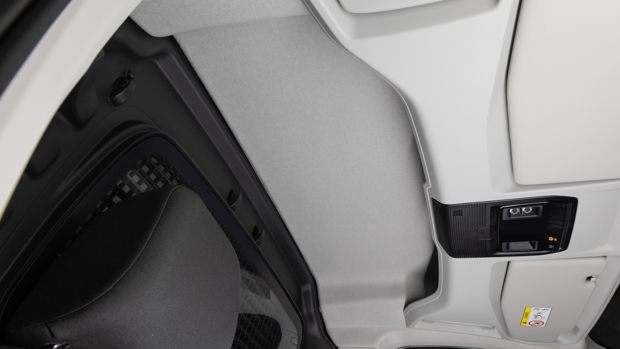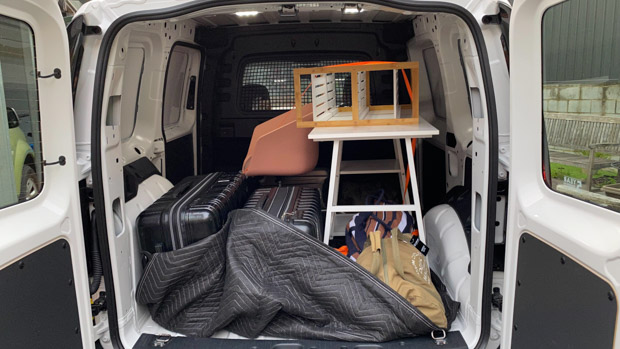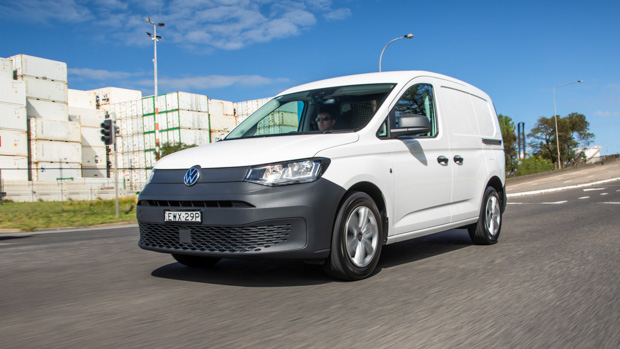-
Car Reviews
- Car News
-
Car Comparisons
Latest comparisons
- Chasing Deals
Everyone’s favourite car/van crossover has been recently updated for MY23, so is it still the go-to for tradespeople and florists?
Like a lot of vehicles in Volkswagen’s lineup, the Golf-based Caddy had a humble start. First introduced to the North American market in 1980, the Caddy was actually a single-cab ute with a payload of 530kg.
But over the four decades since, the Caddy has undergone some significant changes, with its transition into a van being the most significant.

In modern times, the Caddy fills quite a niche area of the commercial segment. Like its forefather, it still shares underpinnings with the Golf (on the MQB platform), but many have found the car-come-van to be extremely useful for practical applications where a full size van or dual-cab ute is simply too large.
Considering that it’s just 300mm longer, and 60mm wider than the Mk8 Golf, the Caddy is the perfect choice for those looking to navigate tight cityscapes whilst also retaining van-like utility and cargo space.
In theory, a van with the footprint of a hatchback should be the perfect vehicle for two inner-city journalists who are moving between apartments, right? Chasing Cars’ very own Zak Adkins and I decided to put this to the test with the Caddy Cargo.

In Australia, the Caddy Cargo is offered in both short- and long-wheelbase forms, with petrol and diesel engines an option in both. Using a long wheelbase Caddy Cargo Maxi would be too easy of a challenge, so we went with Australia’s entry-level shorty.
‘Our’ Volkswagen Caddy test vehicle is more specifically a Caddy Cargo TSI 220 – the most affordable of the Caddy range. It’s priced at $39,990 before on-road costs.
Key rivals for the Caddy include fellow small vans like the Renault Kangoo and Peugeot Partner, while in terms of price the LDV G10 midsize van can be had for similar money.
Make no mistake, this entry-level Caddy is no range-topping California when it comes to frills, and is most certainly a basic commercial van. But let’s dive into what features and specifications you can expect from the Caddy Cargo.

Standard features outside include halogen headlights, a single sliding side door, power windows and 16-inch steel wheels. On the inside, it gets single-zone air conditioning, an 8.25-inch centre touchscreen, an analogue dash with multi-function display, wired Apple CarPlay and wired Android Auto, and a multi-function steering wheel.
However, there is an extensive options list for the Volkswagen Caddy range. Some of the most useful highlights are as follows:
Several accessory packs are also available, including:
The Caddy Cargo is powered by a 1.5-litre turbocharged four-cylinder petrol engine that produces 84kW of power and 220Nm of torque.
The engine is mated to a seven-speed dual-clutch transmission, however a manual transmission is also available for those looking to row their own gears. Like a lot of small vehicles on the MQB platform, power is sent exclusively to the front wheels.

Though Volkswagen doesn’t supply performance figures for the Caddy Cargo, during independent testing, Chasing Cars found that it’ll hit 100km/h from a standing start in 10.87 seconds. This might not sound overly quick, and it isn’t, but it puts it on par with other vans and dual-cab utes. And because of its small size and footprint, it feels faster.
Considering its primary commercial appeal, it shouldn’t be of any surprise to hear that the Caddy Cargo doesn’t get dynamic dampers. Instead, it makes do with a basic coil-sprung suspension system that does a good job of walking the thin line between providing a quality ride and supporting heavy loads.
What are Andy’s thoughts?
My problems with the Caddy start and end with people that claim that it drives just like a Golf. First and foremost, it’s a van, so it doesn’t. Once you get around the fact that the first priority of this vehicle is to haul loads and that it’s not trying to be a fun-to-drive Golf, and its on-road manner becomes a lot more interesting.
The engine is surprisingly responsive and the surge of torque from the turbocharger is fun to play with. At over 10-seconds to 100km/h unladen, it isn’t quick by modern standards, but the 84kW on offer does feel like an adequate amount of power to have fun with.

What I found most remarkable about this little van on the road was how little body roll it has. The ride quality is impressive for a van and for the most part it behaves how you’d expect it to, though it holds its composure incredibly well through the corners.
This could be something that changes with extra weight in the back, but I assume that Volkswagen has tuned the suspension to try and negate the otherwise aloof van feeling.
What are Zak’s thoughts?
Wow, what a fun car this is. I was not expecting the Caddy to be something you would get driver engagement out of. But the Caddy Cargo proves really enjoyable once you spend some time with it.

One thing I love is the discreet blow-off noise from the turbocharger that really puts a smile on my face.
Now, don’t expect the Caddy Cargo to blow your socks off in terms of driving engagement. At the end of the day, it’s a commercial van, not a sports car. But the Caddy Cargo is pretty comfortable to drive around town and at times I often question whether I was driving a van or a car. These little vans have come a long way in terms of refinement.
What the Caddy Cargo did seem to lack was sound deadening (for obvious reasons) and it makes the cabin a little noisy while driving. Also, the rear and side visibility is pretty average, largely thanks to the cargo barrier that is hard to see through as well as large blind spots behind the front seats.

In terms of powertrain, the little 1.5-litre turbo petrol is punchy thanks to 220Nm of torque, at least unladen. However, once the Caddy Cargo is fully loaded up, I do wonder whether the turbo-diesel alternative that offers 320Nm could do the job a little easier.
All in all, I am pleasantly surprised with how much fun I have driving the Caddy, and I’m sure, without a doubt, that Andy will agree with me here.
Inside the Caddy Cargo, it’s a pretty basic interior, however it would be perfect for tradespeople, delivery drivers who don’t lug large payload or small business owners. Volkswagen has fitted its smaller 8.25-inch touchscreen to the Caddy, though a larger 10.0-inch display is optionally available.

On the inside, standard equipment includes a four-speaker sound system, two USB-C ports, FM radio and wired Apple CarPlay and Android Auto.
Other than tech, there is an impressive amount of storage space within the cabin of the Caddy Cargo, including a roof shelf, windscreen compartment, deep door pockets, two cup holders and a storage compartment in front of the gear lever.
For the front seats, they are manual items that feature height adjustment and manual lumbar support. Heated seats are optional and were not fitted to our test vehicle.

Arguably the most important feature of this Caddy Cargo is its load hauling ability, and it comes with a generous helping of space.
All up, the cargo area has a load volume of 3.1-metres, with it being 1797mm long, 1614mm wide, and 1272mm tall. In terms of real-world space, it’ll take a pair of Euro pallets, but that’s nearing the limit.

What are Andy’s thoughts?
There are no two ways about it, the Caddy Cargo is basic, but that’s exactly what many of its target buyers want.
Hard black plastic covers the majority of the interior and the cloth seats are basic. While some might palm this fit-out off as being low rent, I’m under the impression that it’s perfect for an interior that’s going to get dirty. These surfaces are easy to clean.
I appreciate how Volkswagen has retained physical buttons on the steering wheel and that the only, often unloved touch panels you’ll find in the cabin are for the climate controls.

As for technology, the small media screen is easy to use and Volkswagen’s operating system is one of the best on the market. The lack of wireless Apple Carplay might be an issue for some, but it can be had through an interior tech upgrade package.
The basic analog cluster leaves a little to be desired in modern times with digital clusters becoming so commonplace in passenger vehicles, but it’s not out of place in a cost-conscious commercial van and Volkswagen’s familiar design displays all of the information most will ever need.
What are Zak’s thoughts?
We drive a lot of new metal at Chasing Cars. To be honest, I wasn’t expecting much with the Caddy Cargo after driving its more upmarket sibling, the California, last year. But, in truth, the Cargo does its job as a commercial runabout really well.
It’s simple inside and doesn’t have a ridiculous amount of controls or buttons to confuse you. Instead, it’s functional and full of handy cubby spaces to store all of your belongings.

The 8.25-inch display works well and is simple to use, though it is a little annoying that it needs a cord in order to mirror Android Auto.
The instrument cluster is clear and simple, though if I was buying a Caddy Cargo I’d be ticking the box for the optional digital instrument cluster.
While both Andy and I didn’t drive the Caddy Cargo long distance, we did spend plenty of seat time during our respective house moves and its seats are pretty comfortable and supportive. The fabric trim is decent enough if you’re a tradie, delivery driver or a small business owner.

During the move, I found that the Caddy’s load space was perfect for small- to medium-sized items, but couldn’t cut the mustard with the big stuff.
For example, I was able to easily fit a fridge and a washing machine, but had to divert to the back-up plan when it came to larger items such as the bed, bed frame, couch, and a rather long TV cabinet.
While the MPV variant of the Caddy was awarded a five-star safety by ANCAP in 2021, the Cargo remains untested. Despite this, the Cargo does come with an impressive amount of standard safety equipment, especially considering its positioning in the commercial market.
As standard, the base Volkswagen Caddy Cargo is fitted with safety features including front AEB with pedestrian and cyclist monitoring, driver fatigue detection, standard cruise control and lane keeping assist. Features such as rear cross traffic alert, adaptive cruise control, park assist and tyre pressure monitoring are optional.
Driver and front passenger, driver’s knee, front side and curtain airbags are standard fitment across the Caddy Cargo range.
Standard safety inclusions:
What are Andy’s thoughts?
Safety usually isn’t the first thing that springs to mind on the topic of vans, but this one does it quite well. As usual, the Volkswagen safety systems are great to use, and guide drivers without impeding them with rough steering inputs.
Adaptive cruise control would be a nice standard inclusion, as it is on most of Volkswagen’s vehicles in Australia.
The lack of rear and side visibility was my only real concern with this Caddy and both are almost non-existent. Because of this, drivers are left to rely on the blind-spot monitoring system and the lane-keep assist for side visibility, which might not sit well for some.

What are Zak’s thoughts?
There is something about driving a slightly bigger car with a higher driver position that makes you feel safe. The Volkswagen Caddy Cargo ticks a lot of the boxes for standard safety and has an impressive amount of kit for a commercial van.
It wasn’t long ago that work vans were merely bare-boned modes of transport and not safe whatsoever, but I was really surprised to find out that the Caddy Cargo was well equipped in this area. The systems didn’t seem overly intrusive (as they sometimes are) but it’s great piece of mind knowing they are there if something does go wrong.
The Caddy Cargo is covered under Volkswagen’s five-year/unlimited-kilometre warranty. Servicing for the Cargo is $1500 for the five-year care plan, with service intervals every 12 months or 15,000km. At this rate, owners would be looking to spend on average $300 on each visit.
The Caddy Cargo has a claimed combined fuel economy of 6.2L/100km, which seems like a lot for a relatively small turbo petrol engine.
What we actually got during testing was 8.2L/100km combined. The Caddy is able to drop two cylinders during light operation, however we aren’t sure how often this happens.
Keep in mind that the Caddy Cargo needs 95 octane fuel to run rather than regular 91 octane unleaded fuel. This will obviously cost you more at the fuel pump so keep that in mind.
Andy’s thoughts:
I like the Caddy. It’s a quirky number in a somewhat interesting segment and it comes with quirks.
It’s fun to drive and feels well-suited to Australian roads as it does to those tight Sydney CBD streets. Though the entry-level petrol has enough grunt, I’d probably go for the diesel if I was to get one, and the inner bogan would also want a six-speed manual transmission.
Refinement and load space is where this Caddy feels like it comes up short, but unlike Zak and I, those in the market for one will probably be aware of this long before stepping foot in a dealership.

Zak’s thoughts:
The Volkswagen Caddy Cargo is a solid choice for the money and stands out against some of its core competitors: the Renault Kangoo and the Peugeot Partner.
The Caddy is especially targeted toward small business owners or tradies who would really appreciate the amount of load space the Cargo provides.
It’s a simple car with pretty basic features, it’s got plenty of safety features, it’s easy to drive and has a characterful and fun little engine.
But it’s not perfect. The Caddy Cargo would be improved with better sound insulation and even more rear storage – neither Andy or I could conveniently move house with it – and it would start to get expensive by the time you add on some of the more desirable options.
In terms of driving dynamics, the Caddy is a hoot to drive and that 220Nm of torque really helps when attacking hills or overtaking.
My Auntie runs an art shop and would love a car like this. The Caddy Cargo is a very specific car, but it does well for its intended audience. If only it was as nice as the California …
Key specs (as tested)
About Chasing cars
Chasing Cars reviews are 100% independent.
Because we are powered by Budget Direct Insurance, we don’t receive advertising or sales revenue from car manufacturers.
We’re truly independent – giving you Australia’s best car reviews.
The estimate provided does not take into account your personal circumstances but is intended to give a general indication of the cost of insurance, in order to obtain a complete quote, please visit www.budgetdirect.com.au. Estimate includes 15%^ online discount.
^Conditions Apply
Budget Direct Insurance arranged by Auto & General Services Pty Ltd ACN 003 617 909(AGS) AFSL 241 411, for and on behalf of the insurer, Auto & General Insurance Company Limited(ABN 42 111 586 353, AFSL 285 571).Because we don’t know your financial needs, we can’t advise you if this insurance will suit you. You should consider your needs and the Product Disclosure Statement before making a decision to buy insurance. Terms and conditions apply.
Indicative quote based on assumptions including postcode , 40 year old male with no offences, licence suspensions or claims in the last 5 years, a NCD Rating 1 and no younger drivers listed. White car, driven up to 10,000kms a year, unfinanced, with no modifications, factory options and/or non-standard accessories, private use only and garaged at night.
^Online Discounts Terms & Conditions
1. Discounts apply to the premium paid for a new Budget Direct Gold Comprehensive Car Insurance, Third Party Property Only or Third Party Property, Fire & Theft Insurance policy initiated online on or after 29 March 2017. Discounts do not apply to optional Roadside Assistance.
2. Discounts do not apply to any renewal offer of insurance.
3. Discounts only apply to the insurance portion of the premium. Discounts are applied before government charges, taxes, levies and fees, including instalment processing fees (as applicable). The full extent of discounts may therefore be impacted.
4. We reserve the right to change the offer without notice.